Vij D.R. Handbook of Applied Solid State Spectroscopy
Подождите немного. Документ загружается.

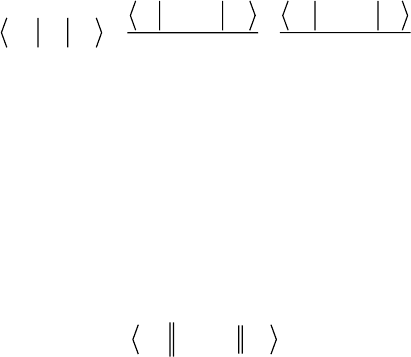
12.5 Processes in Localized Systems
541
large as 6. Based on both theoretical and experimental evidence, it is generally
agreed that the vast majority of fof transitions are electric dipole in nature.
12.5.2.2 Judd-Ofelt Theory of Radiative Transitions for REI in Solids
While the strength of a radiative transition from the ground state to an excited
state is readily measured in absorption, the strength of a radiative transition
between excited levels is not easily determined experimentally. In this section,
we summarize a method (called the Judd-Ofelt method) of predicting the
strength of such transitions for REI in solids [23, 24].
The task is to simplify equation (12.88) into an expression whereby radiative
transition rates can be estimated. We make the first simplification by invoking
the property of closure over the terms of the form
u'
j
u'
j
. To do this, however,
the term Ec
j
must be held constant for all values of j. Thus, the first assumption
in the Judd-Ofelt theory is to set Ec
j
= Ec, making all states of the 4f
n–1
5d
configuration degenerate. We are left with
odd odd
ȥȥ
lkkl
kl
lk
uVeu uVeu
e
EE E E
c
c
rr
r
. (12.89)
This assumption greatly simplifies the calculations. The crystal field operator
and electric dipole operator have been combined, and only the knowledge of the
free-ion 4f wavefunctions is required.
The next assumption is to set E
l
= E
k
, which essentially assumes that the
energy difference between the 4f-levels is much smaller than the
interconfigurational energy. This allows the terms in equation (12.89) to be
combined.
By squaring the resulting matrix element, separating the radial and angular
parts of the integral, and carrying out the necessary tensor algebra, the equation
for the radiative transition probability becomes
2
(Ȝ)
Ȝ
Ȝ 2,4,6
ȥȥ
kl
PU
:
¦
. (12.90)
The \
k
U
(O)
\
l
are reduced matrix elements and have been tabulated [25].
They do not vary significantly from host to host. The :
:
and :
are known
as the Judd-Ofelt parameters, and are experimentally determined using a best fit
to absorption data. In spite of the assumptions, the Judd-Ofelt method has been
generally successful in predicting the radiative rates between REI 4f-levels [26].
12.5.2.3 Radiative Transitions Between d-Levels of TMI in Solids
In Section 12.4.4.2 it was noted that for a TMI at a location of inversion
symmetry (e.g., octahedral), the 3d-orbitals are even. Thus, electric dipole matrix
elements between states belonging to the 3d configuration are zero. For electric
|
²
²
|
||
||
²
²
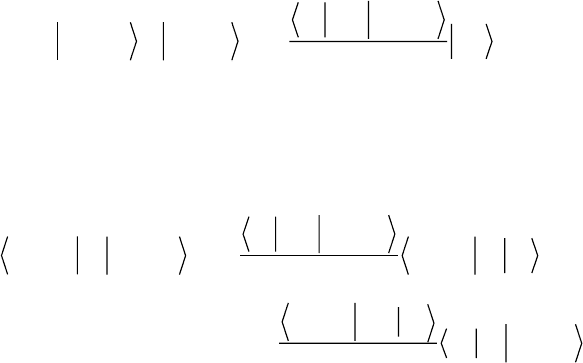
12. Luminescence Spectroscopy
542
dipole transitions to occur, there must be a distortion to the inversion symmetry.
This distortion introduces odd components into H
CF
and mixes the character of
crystal field states of higher configurations (e.g., 3d
n–1
4p) into those of the 3d
n
configuration. This can occur through vibrational motion of the nearby ligands,
but here we assume that the crystal contains a static distortion, and that it can be
treated using perturbation techniques.
Considering the
3
T
2
state of V
3+
in an octahedral field, for example, the
corrected wavefunction, \(
3
T
2
) to the first order, is
3
odd 2
33
22
3
2
T
T
ȥ T'
T
j
j
j
uV u
uu
c
c
¦
j
EE
(12.91)
where u(
3
T
2
) is the state of the system in the octahedral field, represents a
state of an upper (odd) configuration in the same field, and E(
3
T
2
) and Ec
j
are
their respective energies. The odd components of H
CF-static
are labeled V
odd
. A
similar expression can be obtained for \(
3
T
1
) . The matrix element of the
electric dipole operator between the corrected
3
T
2
and
3
T
1
states is
3
odd 2
33 3
12 1
3
2
3
1 odd
3
2
3
1
T
ȥ T ȥ TT
T
T
+ T .
T
j
j
j
m
m
m
uV u
eueu
uVu
ueu
c
c
c
c
c
c
¦
¦
rr
r
j
m
EE
EE
(12.92)
Typically, the energy denominators in equation (12.92) are large (several eV)
and V
odd
is small, so that the transitions are weak: f-numbers are on the order of
10
–4
.
We note that since the spin-orbit interaction is small in TMI, to a large degree
S remains a good quantum number. Thus, transitions between states of different
S values are very weak.
Magnetic dipole transitions are allowed between 3d states, even in a perfect
octahedral field. In spite of this, they are not as important as electric dipole
transitions unless the TMI is at a site having perfect octahedral symmetry, such
as in the host MgO, where electric dipole transitions are strictly forbidden.
Magnetic dipole transitions in TMI have f-numbers on the order of 10
–6
.
12.5.3 Multiphonon Decay
The process considered here is the decay of an excited ion by the emission of
phonons, commonly called multiphonon decay (Figure 12.15). In this section, we
|
|
²
²
u'
j
| ²
|
²
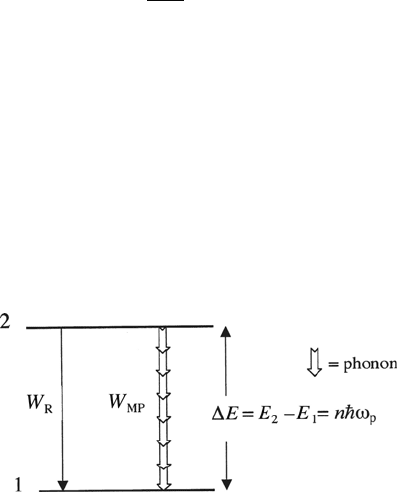
12.5 Processes in Localized Systems
543
find an expression for the multiphonon decay rate of ions in solids, considering
first the case of rare earth ions.
The first step is to express the crystal field as a Taylor expansion about the
equilibrium position of the ion:
CF CF-static
HH hi
g
her order terms
i
i
i
V
Q
Q
w
w
¦
. (12.93)
In equation (12.93) V is the potential seen by the electrons and the Q
i
are the
normal modes of vibration of the lattice. At a lattice site with no inversion
symmetry, the zeroth order term, H
CF-static
, is responsible for breaking the fof
parity selection rule, allowing radiative electric dipole transitions within the 4f
configuration. The first order and higher order terms describe modulations of the
crystal field due to vibrations of the ligands, and is what we have termed H
CF-
dynamic
. It is also called the ion-lattice or electron-phonon interaction. This
couples the motion of the electron to that of the lattice, allowing for phonon
transitions between electronic states.
Figure 12.15 Two-level system showing the radiative (W
R
) and multiphonon (W
MP
) decay
processes.
To obtain an expression for the multiphonon decay rate, one may take the
first order term in equation (12.93) to the nth order of the perturbation.
Alternatively, one can use the higher ordered term in equation (12.93) to a lower
order of perturbation. No matter the approach, the result takes the following
form:
MP MP
() ( 1)WnWn C
, (12.94)
where W
MP
(n) and W
MP
(n-1) are the multiphonon decay rates of an n and n–1
phonon process, respectively, and C is a constant much less than unity. This
leads to the so-called energy gap law [27]:
Į
MP 0
() .
E
WnWe
'
(12.95)

12. Luminescence Spectroscopy
544
W
0
is a constant, and 'E is the energy gap to the next lowest level. If =Z is the
energy of the phonons involved, then 'E = n=Z. The high energy phonons play
the dominant role since fewer phonons are required, thereby lowering the order
of the process. The constant D in equation (12.95) describes the ion-lattice
coupling strength, and is determined experimentally. The energy gap law has
been found to be valid for REI in solids [28].
An alternative starting point for describing the multiphonon decay rate is to
express a non-adiabatic interaction Hamiltonian in the adiabatic approxi-mation.
This leads to a similar energy gap law for the case of REI [29].
The temperature dependence of this process is related to the number of
available phonons in the host, particularly the high energy phonons. The average
occupation number of phonons in the ith mode is N(Z
L
) = [exp(=Z
L
/kT) – 1]
–1
,
and the emission of a phonon is proportional to (N(Z
L
) + 1). The nth order
multiphonon decay rate goes as (N(Z
L
) + 1)
n
. This temperature dependence has
been verified [30].
Observations have lead to the following rule of thumb for REI: If the energy
difference to the next lowest level requires seven phonons or more, the dominant
decay mechanism is radiative; otherwise it prefers to emit non-radiatively.
For TMI, a perturbation approach to multiphonon decay is not feasible. The
multiphonon decay process and its temperature dependence are well described,
however, using the configurational coordinate model. In this model, the ion first
undergoes a non-radiative transition from state v
m
to state u
n
, as shown in
Figure 12.16. This transition is driven by the ion-lattice interaction, and the rate
at which it occurs can be accurately calculated by summing by the Franck-
Condon factors, equation (12.84), weighted of course by the population of the
initial state v
m
. The transition is favored at the point where two parabolas cross,
since that is where the Franck-Condon factors are greatest. Once in the electronic
state u , the system decays rapidly by giving up phonons to the lattice, resulting
in the thermalization of u . The work of Struck and Fonger [31] provides an in-
depth discussion of this method.
| ²
| ²
|
²
|
²
|
²
Figure 12.16 Configurational coordinate diagram showing a non-radiative transition from v
m
to
u
n
.
|
²
|
²

12.5 Processes in Localized Systems
545
12.5.4 Vibronic Transitions
A vibronic transition in emission involves the creation of a photon and a
simultaneous creation or absorption of one or more phonons. Schematic
diagrams of the vibronic transitions are shown in Figure 12.17. At low
temperatures, the vibronic sidebands appear on the high (low) energy side of the
zero-phonon line in absorption (emission). At high temperatures, vibronic lines
appear on both the high and low energy sides of the zero-phonon line. The
vibronic spectrum of Pr-doped YAG is shown in Figure 12.18.
As with multiphonon decay, vibronic transitions are driven by the ion-lattice
interaction. These transitions occur via two different types of processes,
commonly labeled the M and the ' processes [32]. Whereas both processes
apply to the rare earth ions, the ' process is most relevant to transition metal
ions and color centers.
Stokes processes and occur only at high temperatures. (a) and (c) occur at all temperatures.
Figure 12.18 Vibronic emission spectrum of the
1
D
2
level of Pr:YAG at 25 K.
Figure 12.17 Vibronic transitions in (a), (b) emission and (c), (d) absorption. (b) and (d) are anti-

12. Luminescence Spectroscopy
546
In equation (12.87) we saw that the odd components of H
CF-static
causes the
mixing of opposite parity states into the 4f-states of REI, allowing radiative
transitions to occur. The M process occurs when the vibrations of the nearby
ligands introduce odd components into H
CF-dynamic
, thus leading to radiative
transitions. Because they are vibrationally induced, these transitions are
accompanied by a phonon. The M process is especially important in systems
where the ion is at a site of inversion symmetry.
The ' process occurs in systems where the equilibrium position of the optical
center with respect to the ligands changes following an electronic transition. In
the configurational coordinate model, this means that S
0
is greater than zero. For
' processes, the intensity I of the vibronic transitions is given by
I I
0
e
S
0
S
0
N
N
!
(12.96)
where I
0
is the intensity of the zero-phonon line and N is the number of phonons
involved in the process. This function is called a Pekarian distribution, and is
plotted in Figure 12.19 for different values of S
0
. For REI, S
0
§ 0.1, so that that
most of the energy is in the zero-phonon line.
Figure 12.19 Plots of vibronic emission intensity versus number of phonons for various values of
S
0
according to the Pekarian distribution in equation (12.96).
Vibronic transitions of REI can exhibit a strong host-dependence, with the
ratio of the area under the zero-phonon line to the area under the vibronic
sidebands changing by as much as two orders of magnitude depending on the
host [33]. Equation (12.96) is also applicable to transition metal ions and color
centers. For TMI S
0
is between 2 and 10, so they often exhibit a zero-phonon line
and strong vibronic sidebands. In color centers S
0
is often on the order of 30, and
the transitions are almost always purely vibronic.
S
0
=0.1
0
0
0.2
Intensity
Intensity
Intensity
0.4
0.6
0.8
1
1234 0
0
0.05
0
0 5 10 15 20 25 30
n
35 40 45 50
0.01
0.02
0.03
0.04
0.05
0.06
0.07
0.08
0.1
0.15
0.2
0.25
36912
nn
S
0
=5 S
0
=30
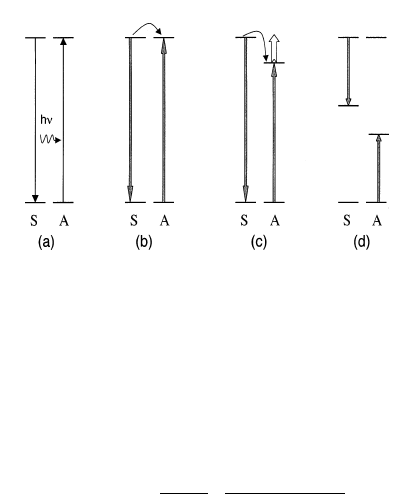
12.5 Processes in Localized Systems
547
12.5.5 Energy Transfer
When more than one optically active center is present, an excited center may
impart all or part of its energy to a nearby center, a process called energy
transfer. This can happen radiatively or non-radiatively.
In the radiative process (Figure 12.20a), the excited ion emits a photon and
another ion absorbs that photon before it leaves the crystal. This process obeys a
1/R
2
law and has little effect on the lifetime of the radiating level.
Some non-radiative energy transfer processes are shown in Figures 12.20b–d.
The ion from which the energy is being transferred is called the sensitizer S. The
ion to which the energy is transferred is called the activator A. We first consider
the case of resonant energy transfer, shown is Fig. 12.20b.
Figure 12.20 Energy transfer processes: (a) radiative, (b) resonant, non-radiative, (c) phonon-
assisted, non-radiative and (d) non-radiative cross-relaxation.
The initial state of the system is an excited sensitizer and an activator in the
activator in excited state. The relevant Hamiltonian is the coulombic interaction
between the electrons of the sensitizer and those of the activator. Forster [34]
and Dexter [35] developed the following equation for the resonant energy
transfer rate W
SA
between S and A:
SA
A
SA
4
S
() ()
IJ
n
gEg E
Q
WK dE
RE
³
. (12.97)
In equation (12.97), K is a constant, Q
A
is the area under the absorption band
of the activator, W
S
is the lifetime of the sensitizer, and R is the distance between
the sensitizer and the activator. g
S
and g
A
are the normalized shape functions of
the emission bands of the sensitizer and the absorption bands of the activator,
respectively. The integral includes the overlap of these two functions, and is
essentially a conservation of energy statement.
The R
n
term is determined by the multipolar interaction between S and A. In
most cases, the dipole-dipole (n = 6) mechanism is dominant. In cases where the
dipole-dipole term vanishes due to symmetry, then the dipole-quadrupole (n = 8)
or quadrupole-quadrupole (n = 10) terms may dominate. The exchange
interaction may also drive the transfer, but is important only when S and A are in
close proximity to one another [36].
ground state; the final state of the system is a sensitizer in ground state and an

12. Luminescence Spectroscopy
548
Experimentally, one can gain insight into the nature of the interaction by
examining the response of the system to pulsed excitation. Based on the work of
Förster [37], assuming an even distribution of sensitizers and activators, the
evolution in time of the population density (n
S
) of excited sensitizers goes as
3/
A
S
S0S
3
() (0)exp 1
IJIJ
q
tCt
nt n
qC
§·
§·
§·
*
¨¸
¨¸
¨¸
©¹
©¹
©¹
. (12.98)
In equation (12.98), C
A
is the acceptor concentration, C
0
is the sensitizer
concentration at which energy transfer is equally likely as spontaneous
S
and q = 6, 8, or 10 depending on whether the multipolar interaction is dipole-
dipole, dipole-quadrupole, or quadrupole-quadrupole, respectively. A best fit of
the decay curve to this equation can be used to determine the type of interaction.
In phonon-assisted energy transfer (Figure 12.21c) the overlap integral in
equation (12.97) is close to zero, and energy difference between the emission of
the sensitizer and absorption of the activator must be made up for by the
absorption or creation of one or more phonons. The following observations can
be made regarding phonon-assisted transfer.
1. The transfer rate obeys an exponential energy gap law if the gap is much
larger than the phonon energy [38], that is, if more than one phonon is
required. This situation is frequently encountered in REI.
2. If W
SA
is much faster than the decay rate of the upper levels of both S
and A, the two levels become thermalized according to the Boltzmann
distribution.
3. For TMI, the phonon-assisted energy transfer rate generally increases
with temperature. For REI, the rate can increase or decrease with
temperature depending on the energy levels involved [39].
12.5.6 Upconversion
The term “upconversion” applies to processes whereby a system excited with
photons of energy =Z
1
emits photons at a frequency =Z
2,
where =Z
2
»
=Z
1
. The
importance of this phenomenon is due, in part, to the fact that it can generate
short wavelength emission without having to rely on UV excitation, which can
have deleterious secondary effects (such as creation of color centers and
excitation of deep traps).
The scheme in Figure 12.21a is called excited state absorption (ESA) and
involves a single ion. In this process two photons are absorbed sequentially, and
the intermediate state is real. Non-radiative relaxation to a lower level may or
may not occur following the absorption of the first photon.
Figure 12.21b shows a process called two-photon absorption (TPA). In this
process, the two photons are absorbed simultaneously, and the intermediate state
is a virtual one.
deactivation, W is the lifetime of the sensitizer in the absence of the acceptor,
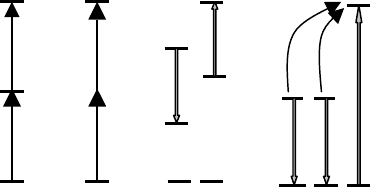
12.5 Processes in Localized Systems
549
Another type of upconversion is a two-ion energy transfer process in which
the activator is initially in an excited state (Figure 12.21c). This is referred to as
upconversion by energy transfer (ETU). Three-ion up-conversion, an example of
which is shown in Figure 12.21d, has been observed, but such processes are very
weak. All upconversion processes are nonlinear, since they require the
absorption of at least two photons. ESA and ETU are the most common.
Experimentally, the two mechanisms can be distinguished from one another by
examining the system’s response to pulsed (laser) excitation. Both systems
show a rise followed by a decay. For ESA-type upconversion, the rise time is
within the lifetime of the pump (laser) pulse. For ETU, the luminescence peak
occurs after the laser pulse is over, with the rise time depending on the decay
time of the luminescent state and the ETU rate. The reader is referred to a recent
review of upconversion processes by Auzel [40].
(a) (b) (c) (d)
Figure 12.21 Upconversion processes: (a) excited state absorption (ESA), (b) two-photon
absorption (TPA), (c) upconversion by energy transfer (ETU), and (d) three-ion cooperative
energy transfer.
12.5.7 Line Broadening and Shifting with Temperature
In this section we discuss the affect of temperature on the width and position of
the zero-phonon lines, particularly in REI-doped solids.
12.5.7.1 Spectral Line Broadening with Temperature
The width of a spectral line is affected by several mechanisms, including
inhomogeneous broadening, direct one-phonon processes, multiphonon decay,

12. Luminescence Spectroscopy
550
radiative decay, and Raman scattering. Inhomogeneous broadening is caused by
variations in the crystal field local to the REI. This effect is not temperature-
dependent, and so will not be discussed here. Direct one-phonon processes,
multiphonon decay, and radiative decay all affect width of the level by reducing
its lifetime. With lifetimes of luminescent REI levels generally longer than a 10
–7
sec, the sum of the contributions of these processes as given by the uncertainty
principle is less than 0.01 cm
–1
. Raman scattering involves the simultaneous
absorption and emission of phonons, usually of two different frequencies. The
electronic state of the ion is unchanged in the process, so that the lifetime is not
affected. Experience has shown that the main contribution to the linewidth is
from Raman processes and is on the order of a few cm
–1
.
Raman scattering is a second order process. Using a perturbation approach,
the probability of the ion absorbing an ion at frequency Z
i
and emitting a phonon
of Z
j
is [41]
ȦȦ (Ȧ )( (Ȧ )1)
ij i j i j
PA N N
. (12.99)
N(Z
i
) and (N (Z
j
) + 1 ) refer to the absorption and emission of a phonon,
respectively, where N(Z
i
) = [exp(=Z
L
/kT) – 1]
–1
is the number of phonons in the
ith mode. A is a constant describing the ion-lattice interaction strength.
Assuming a phonon density of states given by the Debye distribution and
integrating over all allowed phonon frequencies, the contribution to the linewidth
becomes
D
7
/
6
2
D
0
'
(1)
TT
x
x
Txe
EA dx
Te
§·
'
¨¸
©¹
³
. (12.100)
T
D
is the Debye temperature of the solid. Experimental data of linewidth versus
temperature are usually fitted to equation (12.100) treating Ac and T
D
as
adjustable parameters [42].
12.5.7.2 Shift of Spectral Lines with Temperature
In Section 12.4 we discussed the effect of H
CF-static
on the energy of the system.
The contribution of H
CF-dynamic
to the energy of an ion in a solid is revealed in the
shift of the spectral lines with temperature. As in the case of line broadening,
Raman scattering is found to be the dominant process.
The contribution of Raman processes to the energy of the ith level is
CF dyn CF dyn
CF dyn
,
,H ,1,1H ,
į ,H ,
Ȧ
i
jk
ij k
ik jk jk ik
Eikik
EE
rr
¦
=
.
(12.101)
The sum over j includes all the electronic states of the system except the ith
state. The sum over k includes all phonon modes.
